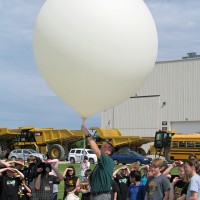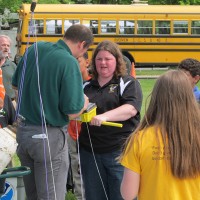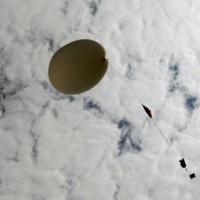Weather balloon launch a learning tool
- Details
- Published on Wednesday, 22 May 2013 17:43
- Written by Paul Gordon
Junior high school students at Riverview Grade School reached for the sky — and then some — when they launched a weather balloon that aimed for the edge of the Earth's atmosphere Wednesday.
With science teacher Emily Dawson and a meteorologist from the National Weather Service leading the charge, the balloon was launched from the Caterpillar Inc. demonstration center in Edwards after a rain delay and traveled northeast before giving way to pressure and popping in space.
A package carrying not only cameras and other tools to record the event but also school memorabilia was recovered in a plowed field just outside of Princeton in Bureau County late in the afternoon. While it landed just short of the projected landing site of Lee County, recovery took longer than expected because a GPS system attached to the balloon failed to transmit the package's location.
Dawson was part of the team that recovered the package, the culmination of a project that started a year and a half ago when she got the idea for the weather balloon after watching a PBS show on WTVP-47.
"I just thought this was a good way to teach my students about weather and meteorology and it can be developed as a resource for other teachers to use," Dawson said a few minutes after she and Ed Shimon, senior meteorologist for the National Weather Service office in Lincoln, teamed with Riverview students on the launch.
While it's still not known how high the balloon reached Dawson was confident it would go at least 90,000 feet. She was pushing for 100,000 feet or better, she added.
While the National Weather Service launches weather balloons twice each day, the pictures and other data aren't readily available to junior high school science students. The data and pictures from this one will be.
Dawson said the fact she waited until almost the end of the school year to do the launch was purposeful. "The kids got more and more fired up about it the closer we got to launch day and now they will be excited coming into next school year when we study what we did here today," she said.
Dawson had no real interest in weather or meteorology before starting this project, but she said outer space has always been one of her passions. She when she saw the PBS LearningMedia program on WTVP, about a school on the East Coast that did a similar project, she decided to start working on one for her students.
"I'm a space nut," said Dawson, "and I'm always looking for crazy, hands-on activities to get the kids excited about science. When I ran across this balloon launch idea on PBS LearningMedia, I knew we had to do it. From research to design to tracking the balloon in flight, there's just so much science potential. Plus, we'll be sending something to outer space. How cool is that?"
She applied for and received a grant from PNC Bank's FirstGrant program to fund the project for Dawson and other Riverview teachers JoAnn Lowry-Emery and Luann Kuehn. The FirstGrant program is designed to help classroom teachers throughout central Illinois accomplish creative and innovative projects they would otherwise be unable to fund because of budget limitations, and it is supported by the Ruby K. Worner Trust and the PNC Foundation, which receives its principal funding from The PNC Financial Services Group, according to a news release.
Other help came from the University of Illinois, which provided the helium needed to fill the balloon. The launch site and equipment used for the launch were courtesy of Caterpillar Inc.
WTVP produced and broadcast a live webcast of the event, which will be archives for future viewing at www.wtvp.org.
Weather expertise was provided by the National Weather Service as well as by Cody Murphy, meteorologist for WMBD-TV.
The balloon itself was approximately five feet in diameter when filled with helium. It's launch box was equipped with multiple HD cameras, a tracking device and data logger for collecting weather information, including temperature, humidity, altitude and atmospheric pressure.
The payload also included logos and lightweight items from participating schools and stations. "Just so we can say we have something that's been to outer space," Dawson added.
Other participating schools with Riverview were Quest Charter Academy and St. Mary's School in Metamora. Altogether about 275 students attended the launch.
Dawson said the introduction to weather unit she started teaching this year not only gets students excited about weather and meteorology but about other sciences, as well. Also, she said, it opens their thoughts to possible careers for when they finish school.




















































